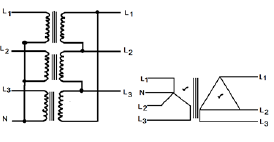ELECTRICAL TECHNOLOGY GRADE 12 MEMORANDUM - NSC PAST PAPERS AND MEMOS SEPTEMBER 2016
Share via Whatsapp Join our WhatsApp Group Join our Telegram GroupELECTRICAL TECHNOLOGY
GRADE 12
MEMORANDUM
NATIONAL SENIOR CERTIFICATE
SEPTEMBER 2016
QUESTION 1: OCCUPATIONAL HEALTH AND SAFETY
1.1
- Remove the person from the heat source. √
- If you are helping someone with a serious burn, keep the burn areas elevated to reduce swelling. √
- (ANY TWO RELEVANT ANSWERS) (2)
1.2
- Attendance √
- Character √
- Team work √ (3)
1.3
- The type of work that will be done in an electrical technology workshop requires the correct lighting level because good visibility is crucial in soldering work, making electrical connections and other electrical work. √√
OR
- Proper lighting improves safety as well as better quality workmanship. √√ (1 x 2) (2)
1.4
- Risk analysis is a process that will help people to adopt a policy of safe practice as an on-going process. √
- As projects in a workshop change according to people’s needs the manufacturing processes also has to change. √
- Safety practices must be included in all stages of planning. √ (3)
[10]
QUESTION 2: THREE-PHASE AC GENERATION
2.1 Power factor meter enables the consumer √ to determine the power factor in the commercial installations. √ (2)
2.2
- Solar √
- Wind turbines √ (2)
A star connected alternator generator produces 1,1 kW per phase. Each phase has an impedance of 44 Ω.2.3
2.3.1
VF =√?? √
=√1100 × 44 √
= 220 V √ (3)
2.3.2
VL = √3?? √
= √3 x 220 √
= 381,05 V √ (3)
2.4 To be able to supply consumers with both single-phase √ and three-phase power. √ (2)
2.5 Measure power √ (1)
2.6 Apparent power is the power without considering the efficiency, losses and power factor of the circuit. S = √3VLIL √√ (2)
2.7 Three-phase systems are more versatile and they can operate in both star and delta. √ (1)
2.8
Pact = Papp x cos θ √
= 300 000 x 0,8 √
= 240 kW √ (3)
2.9
- Less current drawn from the supply.
- Cost saving from drawing less current.
- Less maintenance.
- (ANY CORRECT ANSWER) √ (1)
[20]
QUESTION 3: THREE-PHASE TRANSFORMERS
3.1 Yes √
The primary circuit is complete √ and will have a supply connected across it. √ Therefore current will flow and it will be dependent upon the impedance of the primary circuit and the supply voltage. √ (4)
3.2
3.2.1  (3)
(3)
3.2.2  (3)
(3)
3.3
3.3.1 The current will also double. √ (1)
3.3.2 The voltage will stay the same. √ (1)
3.3.3 The input power will also double. √ (1)
3.4 To reduce eddy currents circulating in the core. √ This causes heat to be generated in the core of the transformer. √ (2)
3.5
- One mark for primary connection
- One mark for secondary connection
- One mark for single-phase transformer (5)
[20]
QUESTION 4: THREE-PHASE MOTORS AND STARTERS
4.1
4.1.1 The current drawn by the motor will decrease. √ Pout =√3VLILcos θ
Therefore IL must decrease. √ (2)
4.1.2
- The output power remains constant. √
- The line voltage remains constant. √ (2)
4.2
4.2.1  (3)
(3)
4.2.2  (3)
(3)
4.3
4.3.1 Three-phase induction motor. √ (1)
4.3.2
- Lifting eye √
- Shaft √
- Laminated steel rotor √ (3)
4.4
- The same size frame a three-phase motor delivers more power. √
- High starting torque. √
- (ANY RELEVANT ANSWERS) (2)
4.5 ????????? ??? ?ℎ??? = 60 ×?√
??
= 60 ×50√
500
=6√√
This mean 6 x 2 = 12 poles per phase
The total number of poles will be 12 x 3 = 36 √ (4)
4.6
- Overload → Automatically disconnect the motor in the event of an overload. √√
- Interlocks/holding out → prevent the timer from being energised before contactor 1. √√
- Normally open contact of a timer. → Connect the second motor after the time has lapsed. √√
- Normally open contact of the main contactor → Latches after the start button has been released. (Holding contact) √√ (8)
4.7
- Check for obvious open/exposed wires, any bare wire carrying electricity is just bad news. √√
- Check the electrical connection in the terminal box. It is vital important that the nuts where the supply leads/cables are joined to the terminal box are tight. √√ (4)
4.8  (6)
(6)
4.9
- Copper losses √
Due to resistance of the copper wire in the rotor. √ - (ANY RELEVANT ANSWER) (2)
[40]
QUESTION 5: RLC CIRCUITS
5.1 Frequency is inversely proportional to the capacitive reactance √ so the increase in capacitive reactance causes the impedance to increase, √ the current will decrease √ and will cause the brightness of the incandescent lamp to decrease. √ (4)
5.2
- Radio tuning circuit √
- Filtering circuit √
- Timing circuit √
- (ANY RELEVANT ANSWER) (3)
5.3 Current is maximum √
Z = R √
XL = XC √
(ANY RELEVANT ANSWER) (3)
5.4
5.4.1  (3)
(3)
5.4.2  (4)
(4)
5.4.3  (3)
(3)
[20]
QUESTION 6: LOGIC
6.1 The internal memory of the PLC store the instruction sets √ /programming for the CPU to access when operating. √ (2)
6.2 Economical √ For a control panel with more than ten relays, a PLC is cheaper. √
(ANY RELEVANT ANSWER) (2)
6.3 PLCs are used to automate machinery in assembly lines and were developed as a substitute for large relay panel √√
No rewiring is needed when the sequence is changed. √√
(ANY RELEVANT ANSWER) (4)
6.4  (6)
(6)
6.5
6.5.1 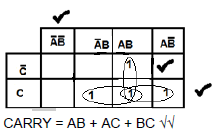 (5)
(5)
6.5.2  (4)
(4)
6.5.3 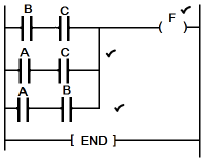 (3)
(3)
6.6 Full marks if answer is obtained using Karnaugh map (4)
Full marks if answer is obtained using Karnaugh map (4)
6.7
- Sequencing of robot √
- Control of machinery in factories √
- Automation of machinery in assembly lines √
- (ANY RELEVANT ANSWERS) (3)
6.8
6.8.1 Normally closed contact √ (1)
6.8.2 Normally open contact √ (1)
6.8.3 Coil √ (1)
6.9  TWO MARKS FOR GROUPING
TWO MARKS FOR GROUPING
F = B √√ (4)
[40]
QUESTION 7: AMPLIFIERS
7.1 Negative feedback is 180o output of phase √ with the input signal.
When the input goes positive the feedback signal will go negative diminishing the gain of the amplifier due to a smaller resulting input signal. √√ (3)
7.2
- The op-amp amplifies the difference between the input signals.
- It operates as a differential amplifier. √√ (2)
7.3  (5)
(5)
7.4
7.4.1 Inverting amplifier √ (1)
7.4.2  (3)
(3)
7.4.3 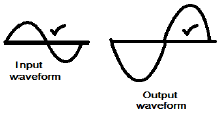 (2)
(2)
7.4.4 The gain is proportional to the value of the feedback resistor √ so die and the gain will also increase. √ (2)
7.5
- Voltage sensitive switch. √
- Supplies a digital output. √
- Output frequency is the same as input frequency. √
- Have two fixed trigger voltages. √ (4)
7.6 A differential amplifier will only amplify the difference between two input signals. √ If they are the same no amplification will take place. √ (2)
7.7 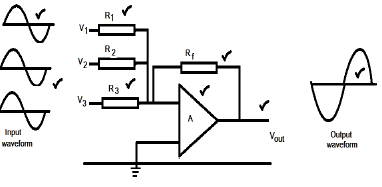 (8)
(8)
7.8
- Audio mixer √
- Digital-to-analogue converter √
- Bipolar to unipolar converter √(Any 2 x 1) (2)
7.9 To integrate a signal representing water flow. √
It can also be used as a ramp generator. √ (2)
7.10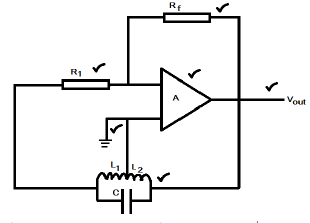
It can be used for generating RF signal. √
It is widely used as local oscillator in radio receivers. √ (6)
7.11
7.11.1  (3)
(3)
7.11.2 It is used at audio frequency as audio oscillator √
Electronic organ √ (2)
7.12
- Day night switches √
- The result is that the output of the Schmidt trigger is changed to switch a light on √
- Wave Shaping Circuits √
- Schmitt trigger swings into an upper or lower saturation point. √
- (ANY RELEVANT ANSWERS) (2)
[50]
TOTAL: 200
